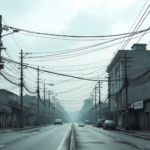A Year of Abundant Rainfall Brings Relief to Mexico City’s Water Woes
Thanks to an exceptionally wet year in 2025, the Cutzamala water system is nearing 84% of its capacity. This positive development, as reported by Mexico’s National Water Commission (Conagua), ensures a two-year supply of potable water for Mexico City, which has long struggled with water scarcity. The city’s government should capitalize on this opportunity to address the overexploitation of aquifers and daily water shortages, particularly in the eastern part of the city.
The Current Situation and Existing Programs
Currently, rainwater often ends up in the sewer system and is mixed with wastewater, ultimately discarded through deep drains into Hidalgo. To make better use of rainfall, the Mexican government has implemented the Rainwater Harvesting Program in seven boroughs: Tlalpan, Tláhuac, Milpa Alta, Azcapotzalco, Gustavo A. Madero, Magdalena Contreras, and Iztapalapa. Under this program, the central government subsidizes 50% of the installation cost for rainwater harvesting systems in participating households.
Nature-Based Solutions (NbS) for a Sustainable Future
To ensure Mexico City’s long-term viability, it is crucial to adopt nature-based solutions (NbS) that leverage the city’s capacity to capture, filter, and reuse rainwater. These solutions include implementing green roofs, urban wetlands, vegetated swales, permeable pavements, green roofs, and arboreal corridors. Such elements allow rainwater to infiltrate the ground or be directed towards storage facilities, reducing pressure on aging drainage systems.
Successful examples of this approach can be found in Barcelona and Stockholm, where street and plaza rehabilitation has decreased flooding while creating new green spaces. The infamous Bachetón could be transformed into a program promoting permeable pavement, alleviating strain on aging drainage systems through green roofs and permeable parks.
Transforming Mexico City with NbS
Implementing nature-based solutions in Mexico City would involve converting impermeable public spaces and roadways into water-retaining and filtering surfaces. Protecting natural wetlands and creating artificial ones in critical areas like Iztapalapa and Xochimilco, along with integrating green corridors to capture rainwater, would help mitigate recurring floods while replenishing the Valley of Mexico aquifer, which is currently overexploited and vital for the capital’s water supply.
Key Questions and Answers
- What is the current state of water supply in Mexico City? Due to abundant rainfall in 2025, the Cutzamala water system is nearly 84% full, ensuring a two-year supply of potable water for the city.
- What programs are in place to address Mexico City’s water issues? The Rainwater Harvesting Program subsidizes 50% of rainwater harvesting system installation costs in seven boroughs.
- What are nature-based solutions (NbS) and how can they help Mexico City? NbS, such as green roofs, urban wetlands, and permeable pavements, enable the city to capture, filter, and reuse rainwater, reducing pressure on aging drainage systems and mitigating flood risks.
- How can Mexico City implement nature-based solutions? Transforming impermeable public spaces into water-retaining surfaces, protecting natural wetlands, creating artificial ones, and integrating green corridors can help address water scarcity and flooding issues in Mexico City.






